Welding Safety Precautions for Unparalleled Protection! Safeguarding Tips
Updated: 20 Dec 2023
118
Welding is considered one of the crucial activities and industries of recent years, which demands attention and safety to keep the workplace and workers safe. One of the most important steps in the welding process is safety, and that’s why you need to pay more attention to your welding safety rules.
In the welding industry, prioritizing a safe welding environment is very important because, every year, millions of people are exposed to potential health and safety risks while welding. The safe welding practices include proper training, safeguarding the workplace, wearing protective clothes, and following safety precautions.
By implementing these safety measures, you are not only safely guarding your welding environment but also securing your workers, which automatically increases your workflow. Having proper safety measures and rules in welding is essential.
Possible Welding Risk and Its Safety Precautions:
Welding is considered a pillar of every society’s infrastructure and comes with a risk. We need to understand those risks and implement robust safety measures for both your working environment and your welder.
This risk involves UV radiation, harmful fumes, gases, intense heat, etc. All these risks need proper safety precautions and safety welding tips. Some of those precautions include welding helmets, flame-resistant clothes, gloves, and much more.
The article below defines every possible welding risk and its safety precautions, so let’s get to it.
Personal Protective Equipment (PPE)
Personal protection is the first and most crucial welding safety, also known as PPE. In this category, a couple of different things need protection, like ears, hands, and eyes; you need tools to protect them.
Welding Helmet:
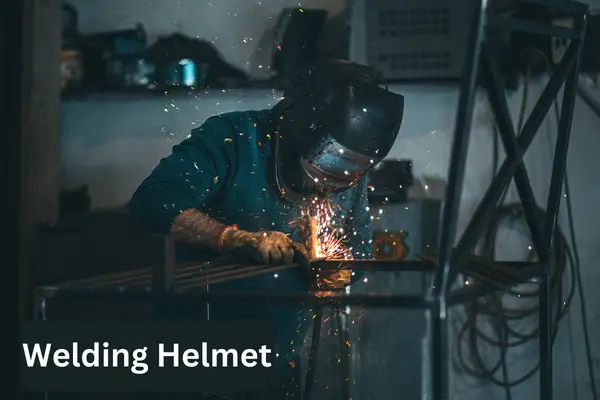
© weldingvilla.com – Image usage rights
A welding helmet is one of the most critical pieces of PPE. The helmet is an essential safety equipment that protects your eyes, face, and overall head from intense sparks and light. There are different types of helmets in the market, manual and automatic. The modern helmet automatically darkens when you start welding.
You can also use welding glasses if you don’t have a helmet, but they only protect your eyes and leave your face and other parts vulnerable.
Gloves:
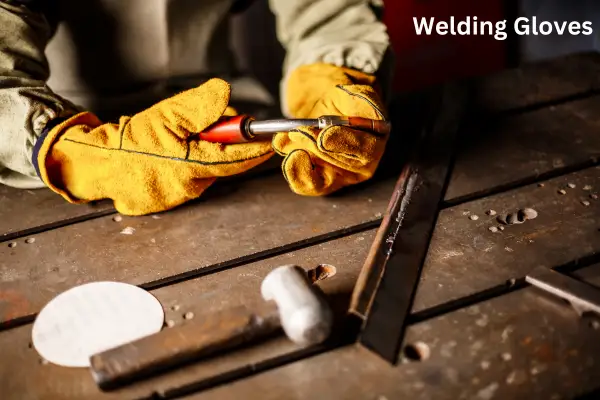
© weldingvilla.com – Image usage rights
Like everything in welding, you need gloves to protect your hands from sparks, cuts, burns, and other abrasions. Usually, you have to use rubber gloves, but it also depends on the welding process and materials used.
The gloves are also suitable for protecting the welder from getting electrocuted. The gloves are considered one of the weld’s main accessories, which you always remember to wear. You can use the welding without gloves but at your own risk.
Flame and Heat Resistant Cloth:

© weldingvilla.com – Image usage rights
Welding is very dangerous and needs proper protection for your overall body. For that, you need protective clothes for heat and flames. These clothes include heat-resistant jackets and pants, which shield your body from sparks and flames.
Most welders don’t wear it, but it’s considered essential and effective in saving oneself from burns.
Respirators:
As you probably know, welding causes bad gases with very unpleasant fumes that can be harmful to anyone inhaling it. Just liberate things. You have to protect yourself from those fumes for the greater good of your health.
To prevent those gases, you need a respirator with a filter for filtering air and preventing you from inhaling any hazardous substances.
Boots:
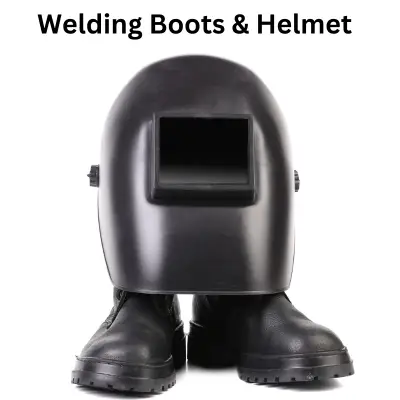
© weldingvilla.com – Image usage rights
Lastly, boots complete your overall body safety covers. It would help if you had rubber boots or steel-toed boots, which save your feet from potential damage like sparks.
Ventilations and Fumes Control:
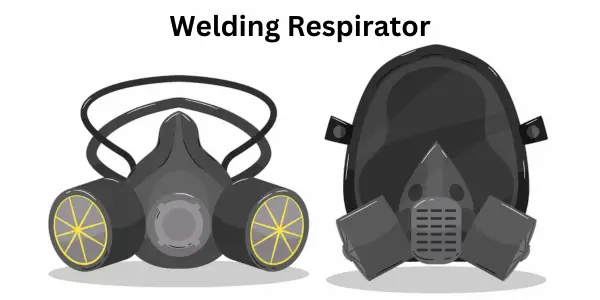
© weldingvilla.com – Image usage rights
During the welding process, burning different metals creates a lot of fumes, which smell very bad. Those fumes are not only harmful but are also bad for breathing. You can use a respirator for it, but not all people have a respirator, and what about people who come in and out?
Local Exhaust Ventilation (LEV):
You must install a local exhaust ventilation system to protect your welding workshop from harmful fumes and gases. This ventilation system effectively removes all the bad fumes and gases directly from that working area and provides you with safe air without any fumes to breathe in.
General Ventilation:
General ventilation is also essential in your workshop or any place where you weld. The purpose of general ventilation is to provide and maintain the supply of fresh air fryers from time to time because the fumes and gas concentration can affect and pollute the overall air.
Fire Safety:
Another name for welding is sewing in the fire, which can catch and cause fire to anything pretty fast; that is why you must make your working area fire-safe and prepare if a fire starts or spreads.
Fire Extinguishers:

© weldingvilla.com – Image usage rights
A fire extinguisher is one of the main mandatory accessories of any place strategically placed in those buildings. Fire extinguishers are the first step against fire, and they are designed to handle it quickly and should be easily accessible to anyone.
Your workshop or where you weld should have one or more fire extinguishers; if you still need to, consider getting one because it could be very effective.
Flame Resistant Barriers:
You should install fire-resistant barriers whenever you weld in a typical area because they could save you from a disaster. Fire-resistant barriers are significant for places outside the workshop, preventing all those sparks from causing and igniting a fire.
These barriers are made from fire-resistant materials and prevent sparks from reaching flammable materials, ultimately reducing the risk of fires.
Clear Work Area:
Usually, people have a lot of things dangling around in their welding area or workshop, making it an easy target to attract fire. To maintain your workshop, you need a clutter-free, organized space that minimizes fire hazards by removing combustible materials.
Electric Safety:
Ensuring electrical safety in welding is as crucial as the precision of the weld itself. From proper grounding to vigilant equipment maintenance, it’s the lifeline that safeguards both the welder and the quality of the work.
Grounding:
One of the things that you should always pay attention to is grounding your welding equipment. It is crucial for any welding area because it prevents electrical shocks. For people who don’t know what grounding means, it connects all the electric components to the ground, making it safe to work with and preventing any future electric shocks.
Insulated Tools:
It would help if you used Insulated tools by taking an advanced step in minimizing the risk of electric shocks, and they also prevent you from shock with direct contact. There are different things, though, which you can make that insulated from electric shock, and the most affordable and standard is using rubber handles.
Avoid Wet Conditions:
Welding in wet areas increases the risk of getting electrocuted to double. The welding area should be dry, and you should avoid working in any damp area in the first place. If your welding workshop gets wet due to some accidents, stop welding until the whole area is dry and can work again.
Training and Certifications:
Safety in welding can only be applied adequately if the welder knows what he is doing, and that can only be achieved if he has proper training and certification.
Formal Training:
Any welder who comes to this field should undergo proper formal training programs where they will have welding safety practices, emergency procedures, and different equipment operations with proper safety.
You should not touch a welding gun until you have undergone base formal training.
Certification Programs:
Certifications are the next step of formal training, in which you have to pass the exam for that particular certification, and only they can certify you as a proper welder. In certification programs, they validate the welder’s competence from different angles and ensure it follows the established safety protocols.
Emergency Procedures:
Every environment has emergency procedures, and they follow them whenever they have an accident. Just like that, the welding workshop should also have an emergency procedure if anything terrible ever happens.
First Aid Kit:
A First Aid Kit is the first step to take against any damage. Just like every other place, a welding workshop should have one that could provide essential immediate treatment to cuts, burns, eye injuries, and any other common welding injuries.
Eye Wash Stations:
In welding, eyes are one of the most exposed to danger, and most of the time, they get damaged by it. Most of the time, your eyes get exposed to different fumes, chemicals, and other contaminants, which could affect your eyes very badly. This is why you should have an eye wash station to wash your eyes occasionally.
Emergency Response Plan:
Every organization has an emergency place, and your welding workshop should have one, too. You might think that it’s not that necessary, but trust me, it is. It treats any accident well and procedures step by step with effective response.
Organized work Area:
It would help if you focused on organizing your workshop and work area for safety purposes and to speed up the workflow.
Well, Lit Workspaces:
Arranging your workspace should be your priority, and it should start any work until you have fixed the mess and arranged everything. It has multiple pros; it enhances visibility so that you won’t lose anything again. The surrounding space is clear, which also eliminates the risk of accidents.
Clear Pathways:
Making new pathways or clearing the existing pathways becomes very helpful, which contributes to minimizing tripping over and causing severe accidents. It has a good impact on the overall process and also increases the weld and safety.
Storage Materials:
Organizing your workspace will help you properly store the materials lying around it. You can then store those materials in properly labeled portions and take them out whenever needed.
Risk Assessment:
The safety of welding needs proper risk assessment that not only helps you save the current welding status but also prevents any future problems.
Identify Hazards:
If you do the risk assessment, you will indeed identify potential hazards with welding. Identifying welding hazards is part of risk assessment. Then, you need to work on different strategies, develop an effective solution to solve that issue, and make it welding-safe.
Implementing Controls:
Once you identify the potential hazard, the next step is implementing controls, which could be anything to solve it. The implementing control includes protective equipment and engineering controls that significantly reduce and eliminate possible risks.
Pre-Work Inspection:
Before starting your welding process, you must properly pre-inspect your equipment and the surroundings.
Equipment Check:
Before starting any welding task, you should thoroughly inspect your welding equipment for safety purposes. These checks include cable checking, hoses, and all the power sources.
Checking Gas Cylinders:
Gas cylinder blasts are common in welding and other mechanical workshops, so you should check all cylinders and ensure they’re fastened securely. Also, keep the cylinder in an upright position and keep some restraints to prevent it from tipping over.
UV Protection:
You may already know that a welding arc creates UV light and radiation, which harms human beings and could damage your eyes and other body parts.
Welding Screens:
Mostly, the welder has glass or a helmet that protects their eyes, but if not, then consider getting one for themselves. You can also use welding screens and position them in a certain way to protect yourself from direct exposure to UV radiation and other workers.
UV Blocking Curtains:
In the welding area, having curtains blocking all possible UV radiation is a safety procedure you should follow. These curtains are designed to stop and minimize UV exposure to non-welding personnel.
Noise Protection:
While welding, you should also take proper safety precautions for your ears because there is a lot of noise in that environment.
Ear Protection:
In those high-noise environments, you need safety and protection for your ears. It would help if you had ear plugs or ear bands to prevent hearing damage, which is the main reason for prolonged exposure to welding noise.
Audiometric Testing:
An audiometric test is a hearing test that evaluates the sensitivity of people’s hearing and is usually performed by an audiologist. It would help if you did periodic audiometric tests for all welders to check and monitor their hearing.
Ergonomics:
Ergonomics here is implemented on both machines and welding surrounding it but mostly focuses on machines.
Adjustable Workstations:
Adjustable workstations can help you increase welding safety by accommodating different angles and heights of welding. It also reduces the risk of musculoskeletal injuries.
Anti Fatigue Mats:
Anti Fatigue mats are a great idea to install in your welding workshop to increase safety and minimize discomfort. These mats allow the user to stand for extended periods without any discomfort.
Post Work Cleanup:
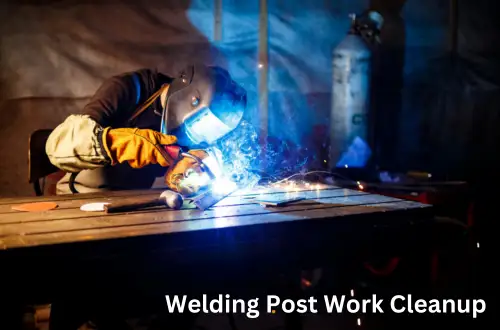
© weldingvilla.com – Image usage rights
Your welding area will be safe from all sorts of hazards and dangers if you keep the whole place clean before and after work.
Removal of Combustibles:
After doing any welding task, combustible material is lying around in your work area, which has a high chance of catching fire. That’s why you should keep the site clean from those combustible materials and ensure it mitigates fire risk.
Cleaning Leftover Debris:
Welding creates a lot of welding remnants and leftover materials in your welding work, which could cause potential danger. This is why it’s mentioned above, and I’m telling you again to clean your surrounding environment from all those leftover materials and debris.
FAQs Section:
What is the safest type of Welding?
TIG (Tungsten inert gas welding) is considered the safest welding to do in all those welding. It also produces less gases and fumes than other welding methods. This welding method is the safest, but it doesn’t mean that you don’t need any safety; that’s why you must take proper precautions whenever you do it.
Is Welding high-risk?
Well, there is a risk in welding, which is considered a very hazardous activity. While welding, you need to take proper precautions against its possible risks, including vision damage, electric shock, fire burns, and explosions.
What should Welders avoid?
There are many things that welders should avoid, like wet surfaces and wearing wet clothes or suits. You must also avoid direct contact with the torch and all the machinery with proper equipment.
Is Breathing in Welding fumes bad?
Well, it’s not bad for a few seconds, but prolonged breathing in those gases could cause lung diseases such as lung cancer, larynx, and urinary tract. Those fumes are nasty to breathe daily, so you should have a mask that keeps you from inhaling the fumes.
Should I Shower after Welding?
Well, yes, you need to shower and change into new clothes. You don’t want to bring those fumes back home with you. You should wash up all the toxic chemicals and fumes from the workshop to keep you and your family safe.
What is the most common injury to a Welder?
Welding causes different types of injuries, the most common being electric shock. It is because there are no proper safety precautions against it. It’s also easy to get electrocuted when you are not paying attention.
Conclusion:
Safety is as important in welding as in other fields; you should focus more on safety in the welding environment because there are a lot of risks and potential hazards that can cause accidents at times. To take care of yourself and your fellow welders and your welding workshop, you need proper safety precautions, which should be mandatory.
I hope you know the importance of welding safety in the workplace. To read more about welding, please visit our main website.
Please Write Your Comments